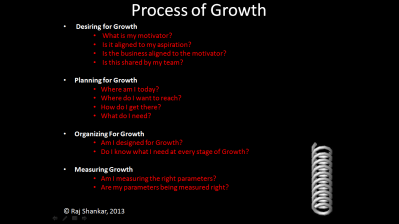Raj Shankar's Blog, page 55
March 29, 2013
Books and Me: Meditation
Author: Eknath Easwaran
Over the course of my life, I have always been interested in knowing more about religion, spirituality and the philosophy behind life in general. At various points in time, I have been led to know more about various religion, their practices, faiths and gods. In the last few years my learning has helped me transcend the differences across faiths and get on the path of advaita or non-duality. The study of Vedanta, has allowed me to clarify the differences between Yoga, Meditation and the numerous other terms that is present in the philosophical literature. If you have been reading this blog even for a short while, you will realise that my interest in this area is only on the rise. The numerous books on philosophy that I have written about in the Books and Me section and the various life’s lesson that I learn and share under the Vedantic Wednesday section are my small way of making my experiences useful to the rest. Sharing my thoughts about this book is also in lines with this.
Any spiritual practice is personal . In this regards I have been searching for numerous methods, practices, techniques from which I may find what’s most suitable for me. A chance occurrence sent me an invitation to attend the Satsang based on Eknath Easwaran’s philosophy in India. During my first meet up I realised that something about his eight point program touched a chord in me. To figure out deeper I requested the other members at the Satsang a book I could read from his stable of publications. This was the book that got suggested.
The book titled Meditation, describes the eight point program devised and practiced by Eknath Easwaran in blue mountain centre of meditation, United States. I thoroughly enjoyed the book and liked his approach of making the entire spiritual activity a daily habit. Even more interesting is his constant reminder to embed the practices into our daily activities of life. Thereby taking the practice of spirituality to where it truly belongs. Though it is only a few weeks since I have begun to attempt practicing his suggestions I am beginning to feel a sense of positivism in making it work.
I wish to reiterate here that I am still not recommending the methodology but suggesting that we must not stop searching the vast literature of philosophy to find what is best suited for each one of us. And as we progress along the journey we may also recognise what we have to drop and what next to pick up.
On a more general note, even if one does not pick up the suggested approach to meditation or any other of the eight point program, I think the chapter on ‘Slowing Down’ is something we can all take-away. I have always been a fan of this particular approach and I was glad to see this to be included this explicitly in his program.

March 28, 2013
Process Of Growth
Everything that needs to be effective has to have an underlying process that is designed and thought of. So should growth.
After having shared with you aspects of growth that travelled with me this week, I would like to place in front of you what I see as a possible process map that we may want to take for our growth journey. The journey should be undertaken in four key stages. Desiring, Planning, Organizing and Measuring.
In the ‘Desiring for Growth’ stage we identify, define and refine the growth motivator (not motivators). We as individuals and as team spend time and effort to understand the ‘WHY’ of our growth journey. This not only sets a common purpose, growth goals etc but serves as a channeliser for our subsequent efforts. This is the key to creating organizational alignment.
In the ‘Planning for Growth’ stage, we step down from wanting to grow to drawing of a more concrete action plan. This starts with an objective assessment our current internal capabilities, our expansion capability (resource elasticity), the steps that we would be taking at tactical and strategic levels, assessing resource requirements for each step and the plan for garnering these resources
The third and the most often ignored phase is the ‘Organizing for Growth’ stage. Very often once you have decided where you want to go, with very little planning, the actions are kick-started. And once you start actually growing, the pressure that it exerts on your already resource constrained current scenario – causes you to either burst at your seams or give up in frustration. Organizing for growth involves you to consolidate, restructure and prepare yourself to welcome and absorb all the demands that the act of ‘Growing’ is going to place on you.
In the ‘Measuring Growth’ stage, you constantly monitor the pre-decided vital parameters that confirm you are growing and growing in the proper direction.
I have enclosed as an image a slide which will give you some insights into key questions that can help you understand and execute these stages in your growth journey,
Happy Growing!

The shape of Growth
For many of us growth is linear. We grow tall, we make more money, we earn more, we have grown from 3% market share to  10% etc But is growth linear?
10% etc But is growth linear?
In my humble opinion, Growth is NOT linear. It is not a straight line that can be extrapolated. Growth in its true essence is spiral. It involves aspects of expansion and consolidation.
The phase of consolidation is very important from two key perspectives. Consolidation, first gives us a breather to view the panorama from our new vantage point. It allows us to take in the scenario from our new position and thereby helping us from being surprised by sudden dynamics.
Consolidation also is a time for preparation. Preparation for taking the next leap(expansion). It allows us to organize and structure ourselves to support the newer dimension we are growing into as a firm.
In the absence of consolidation, we will find ourselves overshooting our internal capabilities Thereby, creating a very weak structure, liable of being toppled any minute.
So as leaders planning growth of our firm, and as individuals who are planning personal growth – it is necessary we ensure we have spent enough time and thought in consolidation

March 26, 2013
Vedantic Wednesday: Growing and Ageing
There is a fundamental difference between ageing and growing. And it is important that we realise this not only for our  spiritual well-being but also for our worldly living.
spiritual well-being but also for our worldly living.
Ageing in any living and non-living thing is an outcome of passing of time. Unlike matter that is insentient, living things undergo a lot more changes because of ageing. Ageing is something that you do not have control on (despite the claims made by various businesses around anti-ageing)
However Growing is a choice that you have. You can choose the pace and the direction of your growth. You can choose the manifestation of growth. It is this that distinguishes a human being from all other living beings. This ability to make a conscious call on the nature of his own growth. Something that a lion, a lizard or the mango tree cannot! However many of us do not spend our time in making and working on this decision.
Due to which the ageing and the growth process become out of synch. You age without growing. This means while your instrument of physical body ages, the mind and intellect remains way behind in development. This leads to a lot of issues at individual and social level.
Sometimes we age and grow. But as this growth is not conscious, there is a lag between our physical growth and our mental and intellectual capabilities. We do not learn as we ought to from having been in existence for a certain amount of time. Our experiences pass our lives either affecting it terribly or without causing any positive impact. We become mere puppets in the hands of time. And very often feel purposeless towards the later part of ageing.
Both these situation leads us to become unhappy, angry, frustrated and helpless. We complain of becoming old.
Those who plan their growth consciously, work with a different agenda. They approach life with a constant urge to learn from it. Every input that comes as an experience is analysed and used to mature the mind and the intellect. This maturity is ploughed in to make the subsequent experience with the world that much better. This constant nourishment of experience and maturity on each other is what defines healthy growing. This is when we age gracefully.
And this requires first an awareness that growth is a conscious choice, second a deep desire to grow and third the commiserative effort to grow.
Are we prepared?


Do you know WHY you want to Grow?
This sounds like a stupid question. Do you need a particular reason to grow? Do you even have a choice? On the surface the cry of opposition is loud and seemingly logical. However none of this can drown the importance of this question. 
Let us assume you are an artiste and this question was asked to you. ‘Why do YOU want to Grow?’ – your answer maybe ‘So that I can play better music, paint better or sculpt better’. Then the effort that you will take to grow; will have to be in taking in inputs that will help you to play better music, paint better pictures and sculpt better.
However let us say you ask this to a manager of the music company, in all probability he will tell you the reason for him wanting to grow is to capture 20% of market share in Tamil Pop Music. Then the actions he has to do would be entirely different and not necessarily in the lines of making his singers sing better.
An artiste who says she wants to capture 20% of market share of listeners and a business man who says he wants to enable his singers realize their singing potential – are in all likeliness going to be working with highly conflicting and contradictory forces internally.
Similarly if a social organization is going to work on any aspect other than impact as its growth motivator and a commercially inclined organization forgets to put profit and value to its shareholder as its motivator for growth – their growth journey is going to be one of internal turmoil (despite external success)
Many times we do not spend time to define the’ WHY’ of our wanting to grow. We don’t know whether we want to grow to become best product creators, we want to grow to make profits or we want to grow for becoming the best place to work etc. When you and your team are not sure of WHY you want to grow – every time you take a step someone is going to raise a question on whether it is the right step. This will slow you down and eventually get you to a stop.
So to continue to grow, you need to have a strong WHY first!


March 25, 2013
What is Growth?
I am heading on Wednesday to meet a group of entrepreneurs at Trichy STEP (trec-step). I have been asked to speak to them on aspects of growth and how one ought to view Growth. As I was mulling over this some thoughts came to my mind on – What exactly is Growth? Have we understood its contours as they deserve to be understood?
on aspects of growth and how one ought to view Growth. As I was mulling over this some thoughts came to my mind on – What exactly is Growth? Have we understood its contours as they deserve to be understood?
When you look at a mammal other than man, within matter of days if not hours, they learn to fend for themselves. Does that mean they can boast of a better growth than a human being?
There are firms that have lasted for 100 years but are still obscure in terms of their revenue. There are also firms that have come on the horizon, grown very fast in numbers but one wonders of their longevity. Which among these have grown?
Growth we are told is painful. But when growth is natural we are told the pain is far less. Then why do we so often intervene? As human beings why we goad a child to walk and not wait for it to learn? Why do we goad it to talk and recite – without waiting for it to pick on its own? Is this intervention good – in life and in business?
Is growth a year on year figure? Is it linear? Or does it move only through periods of consolidation? Can you run and direct your course? When you are running does it make sense to stop, to determine the direction? Is that even practical?
I am not sure of the answers yet.
But I know growth means different things in different context. I understand there is an underlying motivation for growth and understanding that is key. But till I figure more out – why don’t we share our thoughts on these!


March 23, 2013
Interesting Links This Week: 24-Mar-2013
This week these made it to my list
a) Are you following these accounts on twitter? If you don’t you could be missing on the most relevant though t pieces.. but if you do you could be swamped by too much of the best. The question is how intelligent are you in managing the information you subscribe to. But for starters, the list can prove useful for many of us http://www.huffingtonpost.com/vala-afshar/twitter-business-tech_b_2355700.html?ncid=edlinkusaolp00000003&ir=HuffPostBlog
t pieces.. but if you do you could be swamped by too much of the best. The question is how intelligent are you in managing the information you subscribe to. But for starters, the list can prove useful for many of us http://www.huffingtonpost.com/vala-afshar/twitter-business-tech_b_2355700.html?ncid=edlinkusaolp00000003&ir=HuffPostBlog
b) A short and sweet blog – from which I definitely had a couple of take-aways, especially on the smart phone device and sleep http://mistakebank.caddellinsightgroup.com/2013/01/my-2013-resolutions-task-prioritization.html?utm_source=dlvr.it&utm_medium=twitter&utm_campaign=Feed%3A+TheMistakeBank+%28The+Mistake+Bank%29
c) Another insight in the healthcare space – this on retailing of health insurance http://www.huffingtonpost.com/2013/01/17/walmart-clinics-health-insurance_n_2498339.html


March 22, 2013
Books and Me: What’s The Big Idea
Authors: Thomas Davenport and Laurence Prusak
From two of the leading thinkers in knowledge management comes a rather different book on one specific aspect of knowledge. Numerous ideas in business and management domain are produced, practiced, hailed and dropped every year. This book provides some insights on why some of them become successful and some become fads. The book broadly speaks about the thinkers behind these ideas, the ideas themselves and the people who put these ideas to practice. The last group have been given a nice name called ‘idea practitioners’. As the author’s clearly point out most of us are exposed only to the ideas and the larger than life thinkers behind them. The key element in making the ideas useful thereon bringing the guru status to the thinkers behind them are largely ignored. These are the idea practitioners, the people who live on the boundary of thriving organizations, who choose and influence the ideas within their enterprises.
While the predominant focus of the book is on idea practitioners the chapter on people behind the ideas – namely the gurus is also very interesting. Couple of case studies clarify the importance of the three key pieces namely the idea, the guru and the practitioner in any idea becoming a success. The book has useful takeaways for practitioners seeking fast growth and an equal amount of takeaways for thinkers (aspiring ones) too. Anyone interested in knowledge management as an area will also find useful inputs and directions for further reading.


Engaging Your Customers
What started this Monday as sharing of an experience, led itself into a stream of thoughts and possibilities that I have been  sharing over the last four days. The one you are reading is also an extension in the same line of thinking and also its culmination.
sharing over the last four days. The one you are reading is also an extension in the same line of thinking and also its culmination.
Yesterday’s blog discussed some thoughts around capitalizing the ‘Thrill of First’ of our customers. But what happens to the majority of our customers who have been with us for a long time? With many of them our business may have established a certain level of comfort and along with it a mutual plane of expectation and tolerance. At some point this could degenerate into ‘Rot Of Routine’.
Those of us in business long enough would have invariably experienced the ‘yanking of the carpet’. Just because you have been with your customer for a long period of time, does not guarantee immunity against an ouster by a stranger. Most firms live in the fear of upcoming and interesting competition, which can change the level of the playing field overnight.
Some of the questions given below and thoughts in those lines could help us overcome such uncertainties and fears – by channelizing our efforts in the right directions:
Do you consider yourself a part of your customer’s business growth? What are the steps that your firm is taking to keep the freshness alive in the relationship? Is your customer seeing visible efforts taken by you to change yourself to cater to his changing scenario? Is he seeing your organization and its competencies evolve to measure up to his future challenges? Can he see you think ahead for him? Can he see your involvement in his Is he involved enough in your growth journey? How responsible is he feeling towards your growth?
There are many theories and techniques professed in the literature of customer relationship management, sales, strategy and innovation – that talk about the why and how of intensely engaging with customers. But according to me the simplest way is to be genuinely interested in your customer’s growth at the intention level and display commitment to the common cause of his firm’s growth through your actions!
Any thoughts?


March 20, 2013
It could be the first time for Your Customer
Well, the Thrill of First for the young chaps proved a point of great consternation to the flight team. They were visibly  relieved to have the group de-board the plane at Chennai. As the thoughts around this incident, were organizing themselves in my mind, I was wondering how many of us feel the same way when we deal with our first time customers?
relieved to have the group de-board the plane at Chennai. As the thoughts around this incident, were organizing themselves in my mind, I was wondering how many of us feel the same way when we deal with our first time customers?
For these first time customers – sales team in all probability would have bent their back to get them into the firm’s fold. Now, this customer expects a certain level of service for which the delivery and operation’s team are made to toil. Quite often, ‘the first time customer’ label gets many favors for the client – with the business constantly fuming underneath. When the project is completed you breathe a sigh of relief rather than a shout of success!
On another note, first time customers genuinely face adjustment issues. In their nervousness of having to trust you without knowing you; they tend to adopt a veneer of being demanding, cautious and superior. This attitude makes establishing the equation with them even tougher.
In midst of these two forces at play, the customer de-boards at the destination. And quite often does not return.
So once again the sales team starts to court another ‘First Time Customer’.
Is there a lesson that we can learn from the flight experience? Is it possible that the aviation company can identify its first time passengers? Could it have then designed a quick orientation to make these passengers feel special and comfortable while ensuring the rules of the game are politely but firmly drawn? Could they have trained their ground staff and crew to understand the level of expectation, the concerns and the curiosity of the ‘First Time Customers’? Would these have resulted in a better overall experience for all involved?
Do we have some lessons on how we treat our first time customers here? Is that line of extrapolation worth a thought?
PS (assuming blogs have PS): For the first time visitors and the wanderers who have landed on this post, this is a continuation of the thought process that was triggered by an innocuous experience that I had on a recent flight to Chennai. To follow the trail of thoughts you may want to start from the beginning Thrill of First, Rot of Routine & Life is an Art







